I have showed plays using both the 1-4 high set as well as the horns set. Now I am detailing four plays out of the same formation but using a post entry to start the quick hitter. The post entry gives the offense a different approach to plays using the same formation. By using the same starting look, the defense can be kept off-guard as to what the offense is doing with each play.
I like using a post entry to start quick hitters. The reason is most 4’s and 5’s do not have the ball in their hands much with most offenses, and this means their defender is most likely not great at guarding the ball. The offense is forcing a defender not used to guarding the ball to do exactly that. It is also forcing the on the ball defenders most of the time to guard off the ball. This switch can exploit weaknesses in defenders that may not be well known or scouted. Some good on the ball defenders are really bad at guarding off the ball.
So here are four plays in a 1-4 high set using a post entry to begin the quick hitter.
Play #1

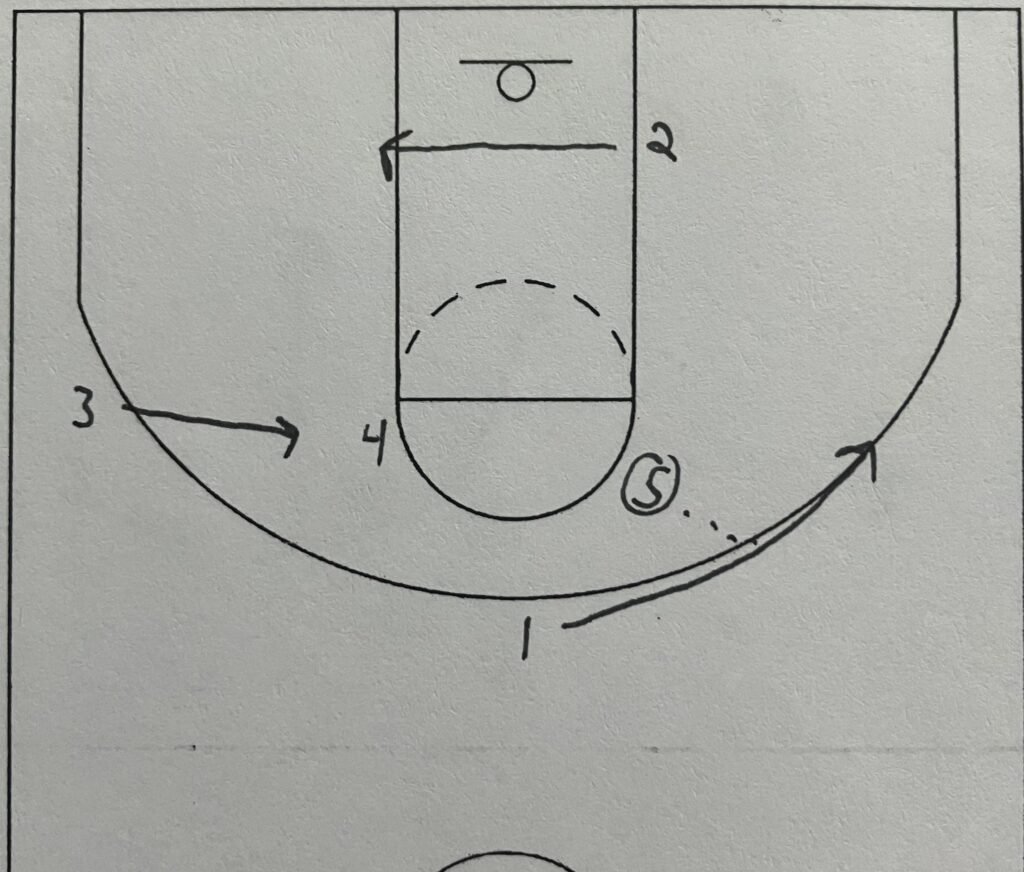

The first play starts with an entry pass to the center(5). The guard(2) immediately backdoor cuts. This is the first option and it will be open once in a while for an easy layup. The key to this is the guard(2) taking a step out away from the basket and then sprinting hard straight to the basket. If the guard(2) defender is not paying attention, then this backdoor will be open.
If the backdoor cut is not open, then the guard(2) continues across the lane to the other block. The wing(3) steps into the elbow with the forward(4). As these players are moving into positions, the point(1) makes an over cut and either gets a pass or a handoff from the center(5). Now there are 3 scoring options to finish the play.
Option #1: The point(1) gets the pass or handoff from the center(5) turns the corner and goes to the basket. By the guard(2) moving across the lane after the backdoor cut, this should take away the help side defense giving the point(1) a better chance at getting all the way to the basket off the pass or handoff.
Option #2: The center(5) dives after the pass or handoff and gets an immediate pass back from the point(1) for a layup. If the defense is hard hedging the pass or handoff then the center(1) might be open on a quick cut after the pass or handoff.
Option #3: If the point(1) or center(5) does not get anything on the front side of the play, then the wing(3) and forward(4) are setting a double screen for the guard(2) to use to come back up for a top of the key 3-pointer. The hope is that the defense will either stay with the 3 on the backside and it will be open for the point(1) and center(5). Or the defense will rotate to the frontside to help with the point(1) and center(5) leaving the guard(2) wide open off the double screen.
Play #2

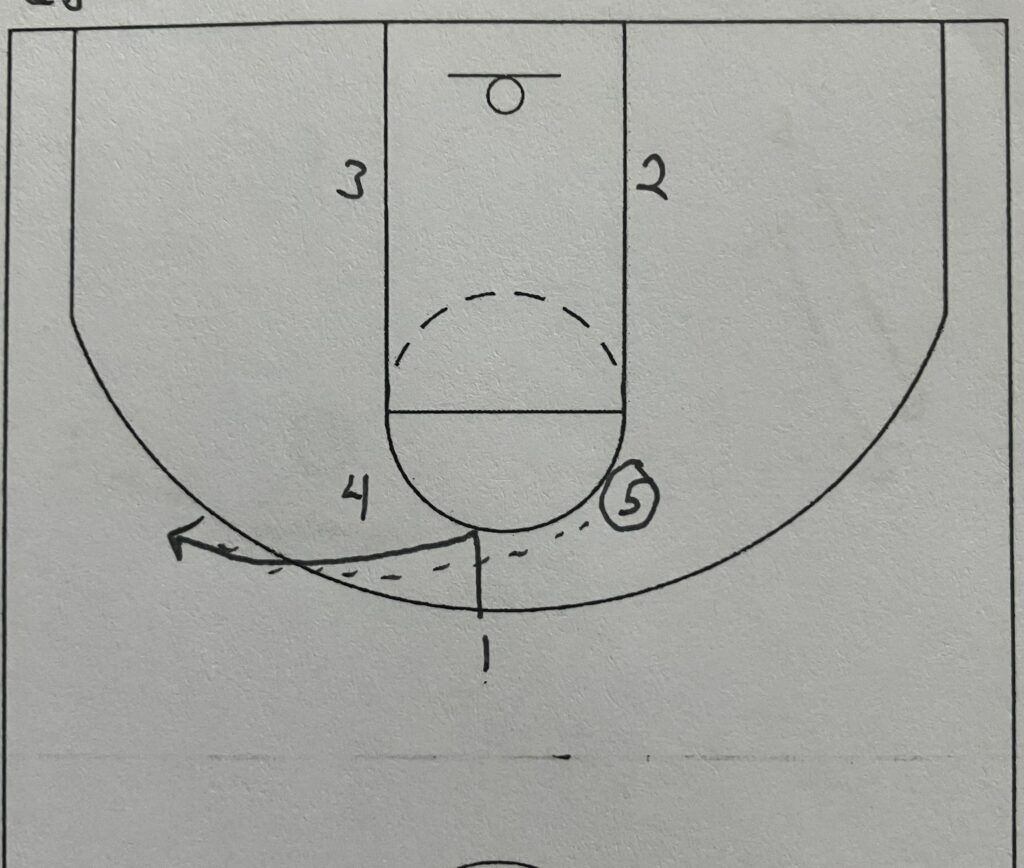
The next play starts just like the previous play. Again this is by design to show the defense the same setups but change what is taking place. The point(1) enters the ball to the center(5). Now just a slight change from the previous play. The guard(2) is still trying for the backdoor cut and layup. The backside wing(3) is cutting to the block as well. This cut clears out the entire backside of the floor. Play #1 attacks the defense on ballside. This play is looking to attack using the backside of the floor.
After the backdoor cuts, the point(1) is coming off of a flare screen by the forward(4). Again I am looking at attacking the backside of the defense. The point(1) comes off the flare screen looking for a flare pass from the center(5). The wing(3) cut has to occur to clear out the space for the flare to happen. If the point(1) has the open shot off the flare screen, then that is scoring option #2.

After the flare screen and pass, the point(1) has a lot of options and decision making left to do. The forward(4) turns and sets a ball screen for the point(1). The wing(3) continues his cut out away from the ball. The guard(2) and center(5) are setting a double stagger screen for the wing(3). This double screen away is forcing the defense to either help on the ball screen and leave the backside open. Or set on the backside and leave the pick and roll open. Whatever the defense does, there are 3 main options for the point(1) once they catch the flare pass.
Option #1: The point(1) can refuse the ball screen from the forward(4) and attack the baseline. This could be left wide open if the wing(3) defender chases or follows the wing(3) around the double screen. With nobody else there to help the point(1) could have an easy layup.
Option #2: The point(1) uses the ball screen and the point(1) and forward(4) play a two man game with either a pick and roll or pick and pop. Again, how the defense chooses to defend the ball screen could lead to any number of scoring chances with the pick and roll.
Option #3: The defense stays and helps with the pick and roll leaving the backside wide open. The point(1) comes off the ball screen with the help side defense waiting on them. So the wing(3) runs off of the double screen wide open for the kick out 3-pointer.
Play #3
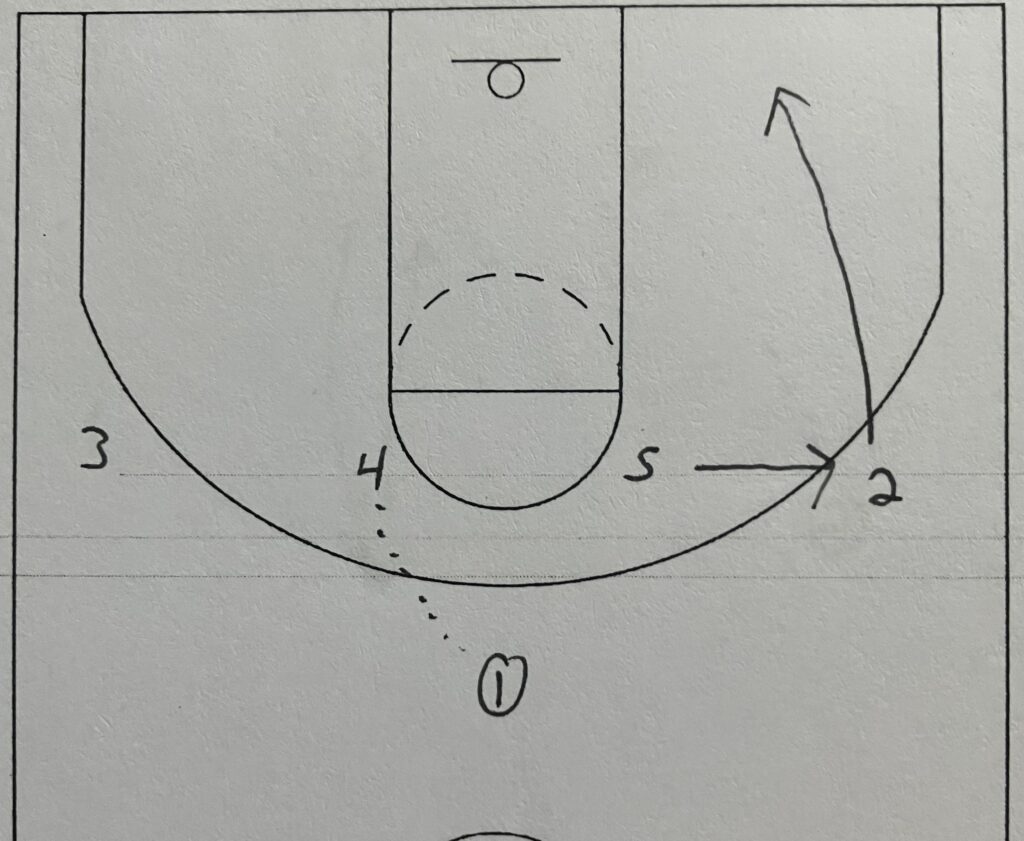
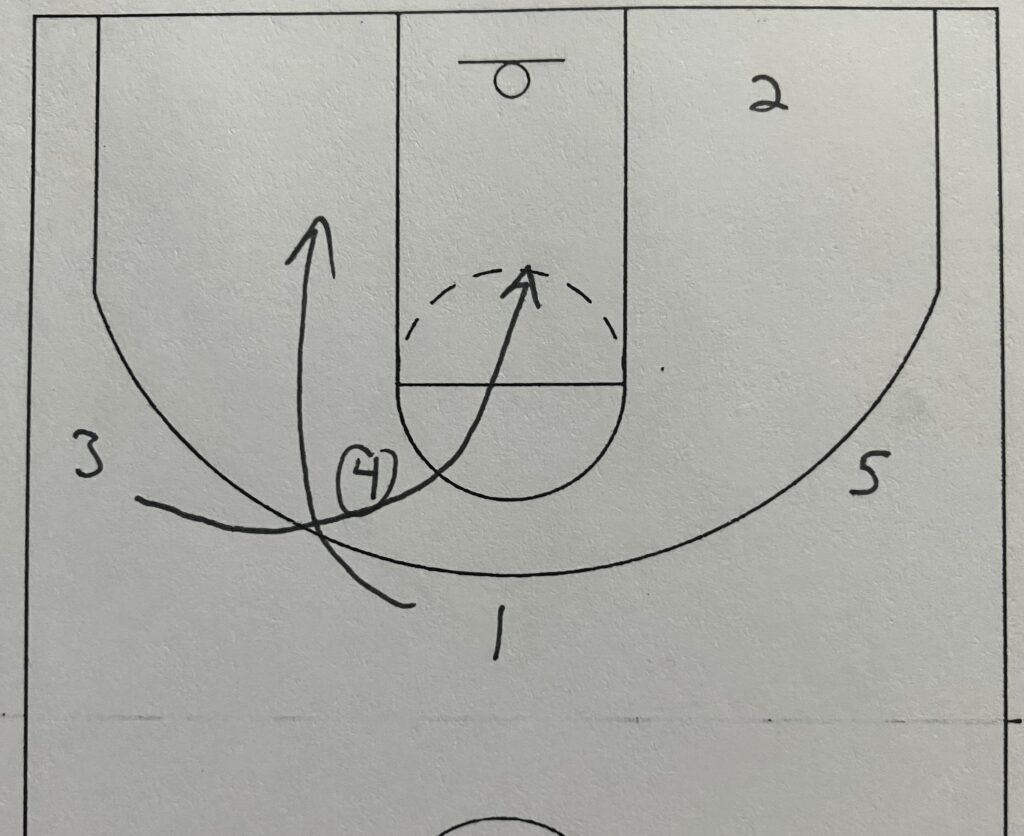
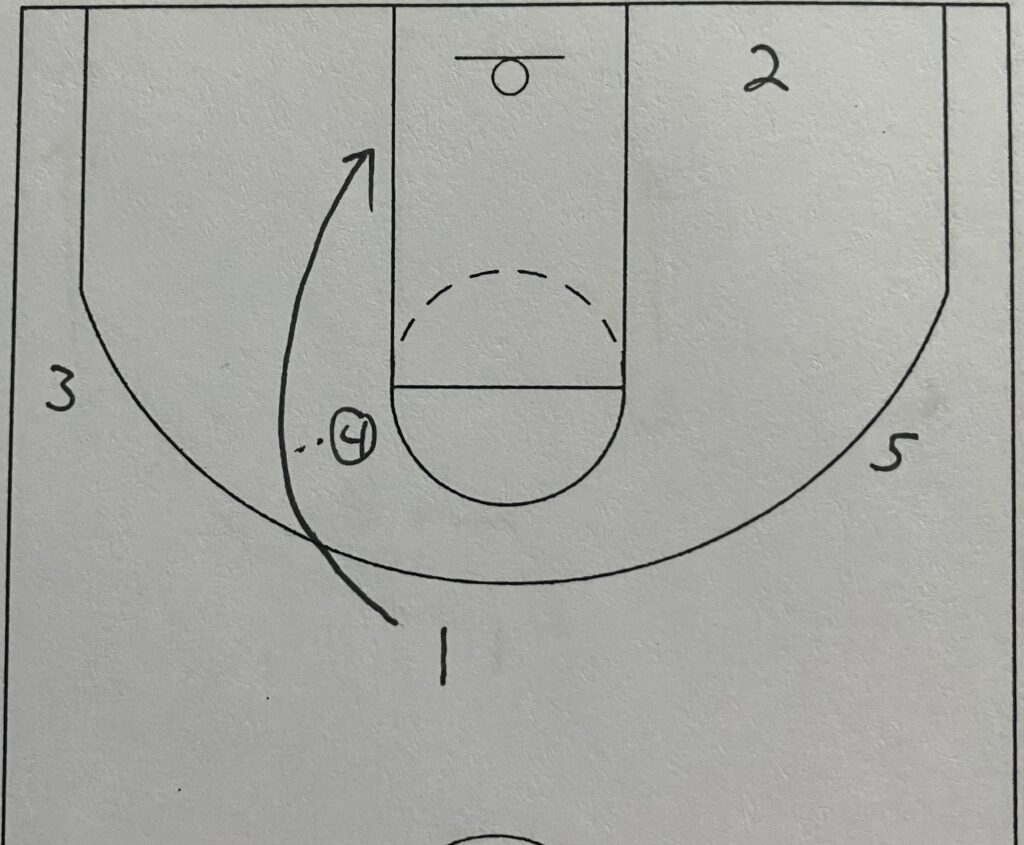

Play #3 is using a scissor action to create openings. It starts with the point(1) passing the ball into the forward(4). All of these plays could start on either side, however, with this play I want the ball going away from the center(5) to start. The point(1) and wing(3) are going to scissor cut or X-cut off the forward(4). In both cuts the forward(4) can handoff the ball to their teammate or they can keep the ball. There is going to be a second action after the scissor cuts.
The point(1) cuts right behind the initial pass. There can be a handoff and possible layup on that handoff. Then the wing(3) will cut off the forward(4) on the other side creating the scissor look or an X-cut. I have heard this type of cut called both scissor and X. The 2nd option is a handoff to the wing(3) coming around to attack the basket through the middle.
As the scissor cuts are taking place, the center(5) needs to step out to the wing and the guard(2) needs to drop down into the short corner area. The short corner keeps the defender from planting themselves right in the middle of the lane thus preventing a layup for the point(1) or wing(3) on the handoff.
If the forward(4) keeps the ball off the 2 possible handoffs, then the play moves into the 2nd action.
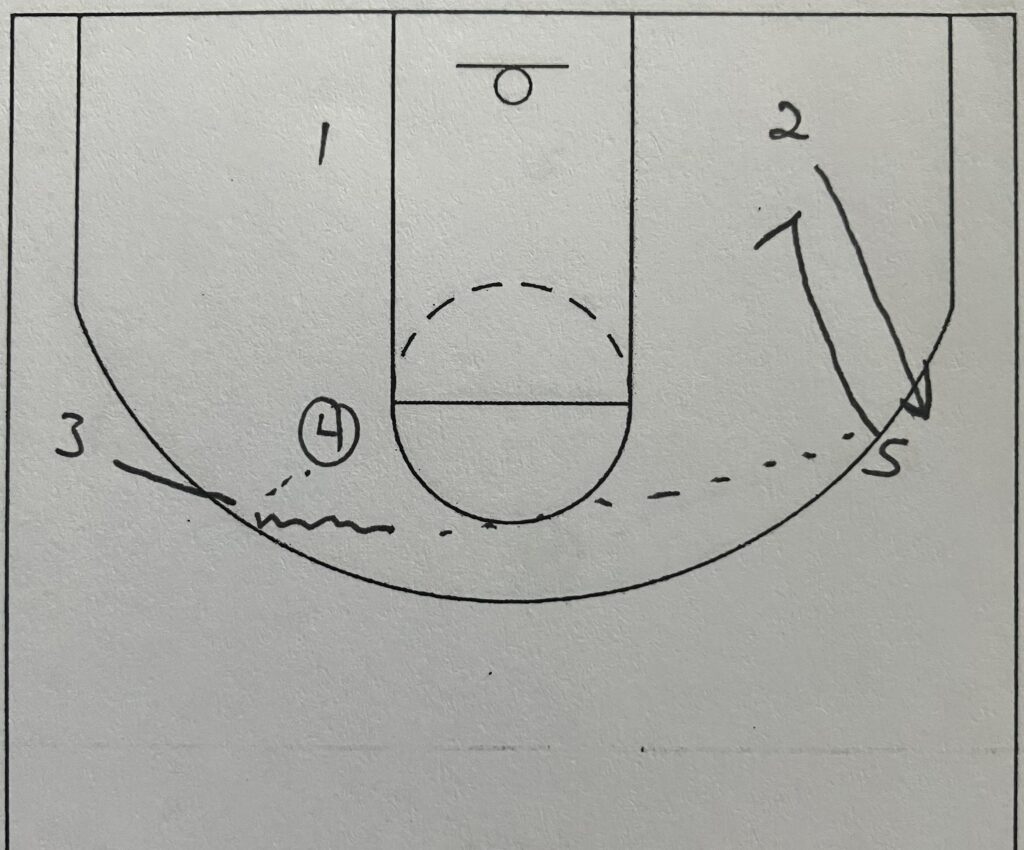
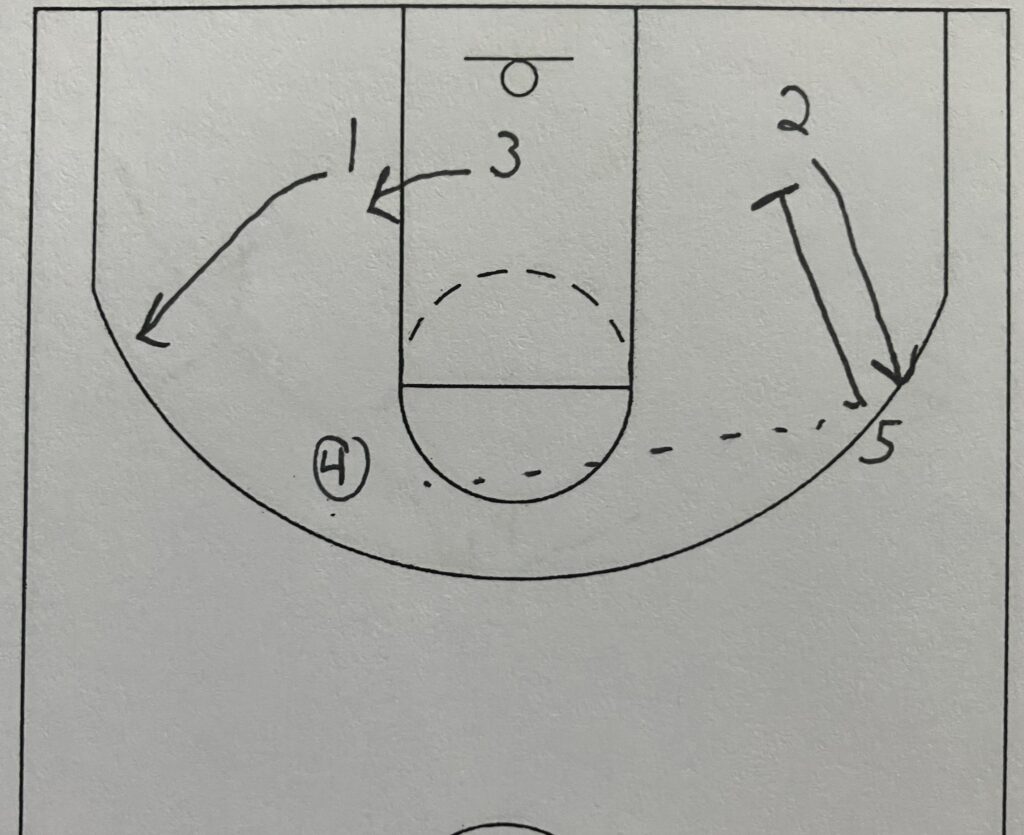

The 2nd half of the play can start in two different ways. The 2nd action can start either with the handoff back to the wing(3) or by the forward(4) keeping the ball after the scissor cut. In both instances the center(5) is setting a down screen for the guard(2). The ball is going to get to the guard(2) either off a pass from the wing(3) after the handoff or a direct pass from the forward(4) to the guard(2) if the forward(4) does not give the ball up on either handoff.
On the catch the guard(2) is making a post entry to the center(5) sealing after the down screen. The final end of the play creates an isolation for one of the two bigs. Whoever does not get the initial pass is going to be isolated. At the beginning of the play, I said I wanted the ball passed to the forward(4) and not the center(5). This final step is the reason why. I want to isolate the center(5) in the post so the ball needs to start with the forward(4).
On the entry pass and catch, the forward(4) and wing(3) are going to interchange. This is to counter the defense no matter what they do. If the defense doubles the center(5), then the guard(2), wing(3) or forward(4) should be open depending on which defender came to double. If there is not an automatic double, then the interchange should occupy those two defenders leaving no time for those defenders to help on the center(5) when the center(5) makes their move. That small interchange can create a bunch of problems for the defense. Those problems should lead to open shots for the offense.
Play #4
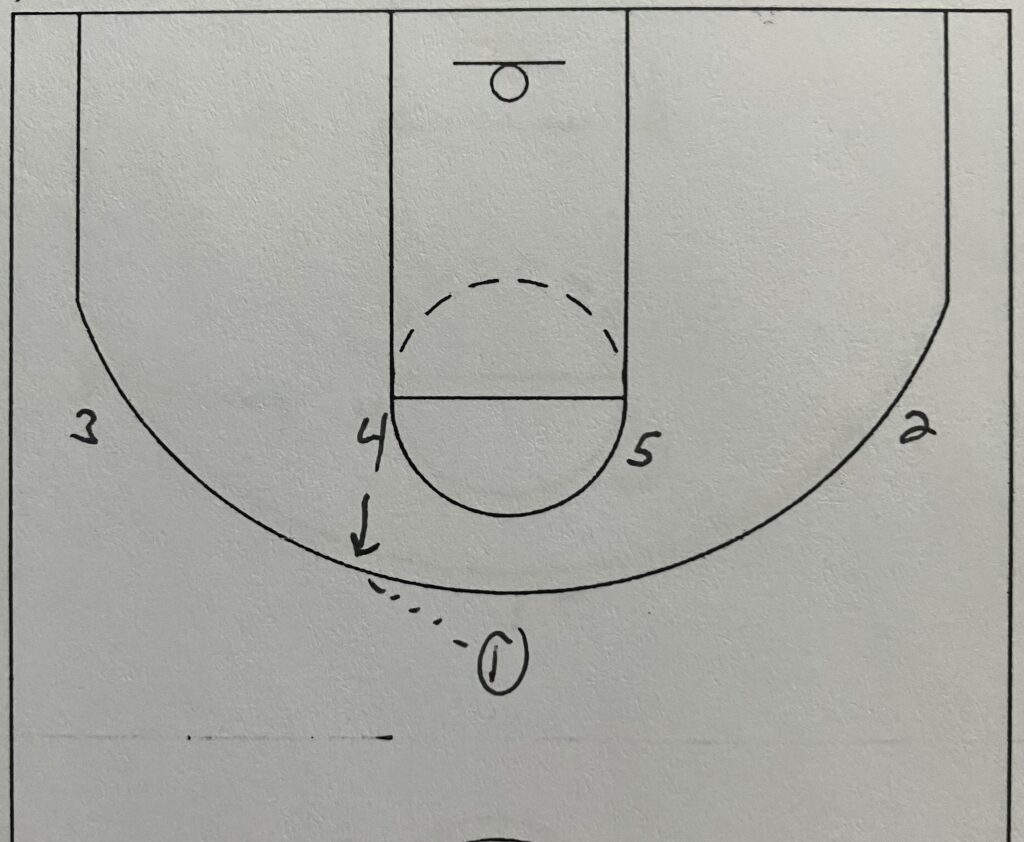
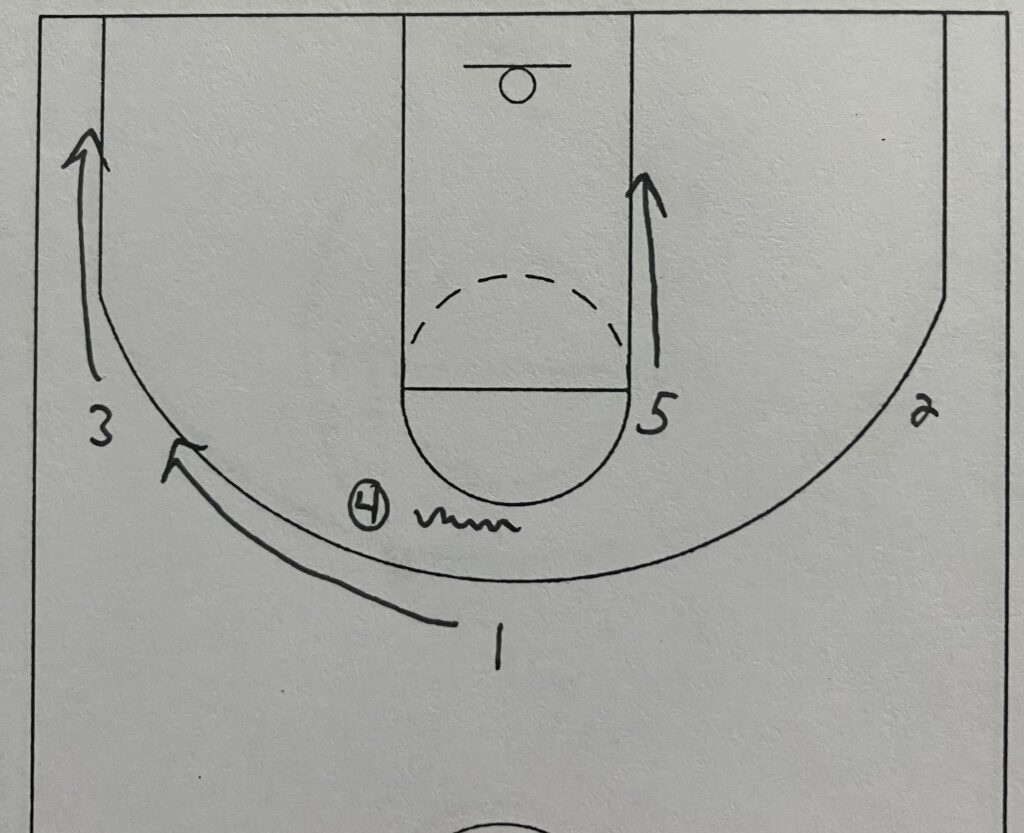
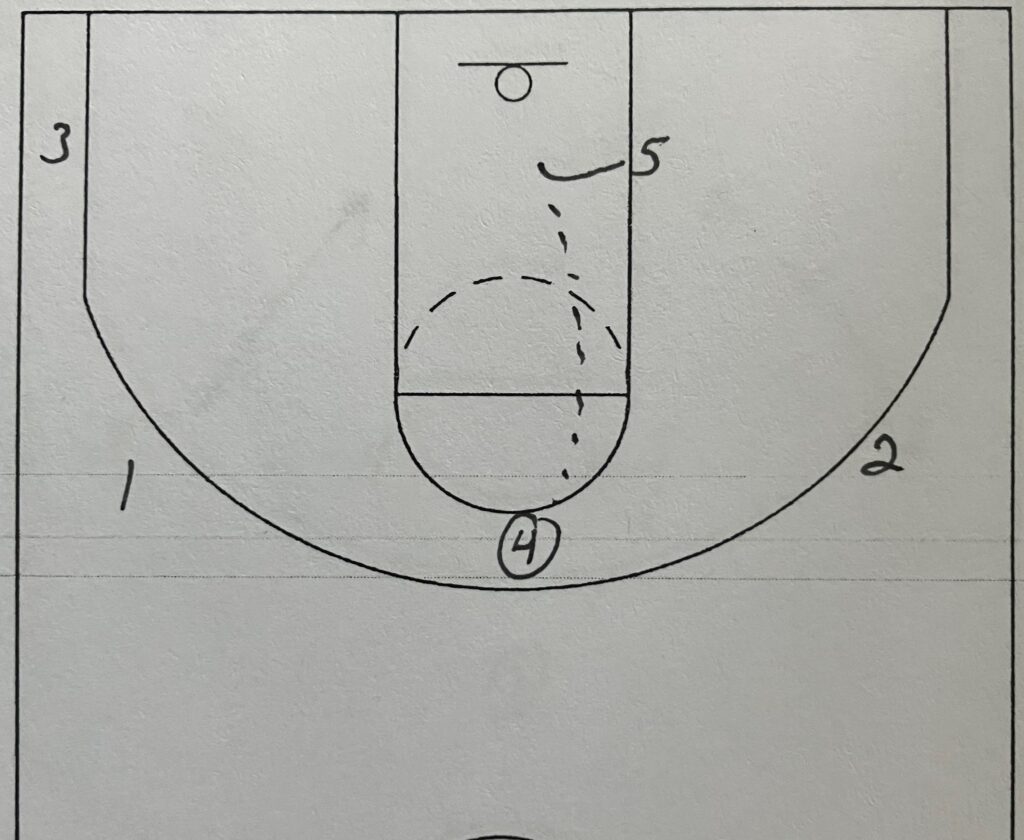
This play is a nice play that is super quick. The point(1) passes to the forward(4). The forward needs to step out to the 3-point line for the catch. This creates space in the offense. Off of the initial pass, the point(1) runs on over cut to the wing. The wing(3) slides down to the corner. This over cut keeps everybody out of the lane. As the over cut is happening, the center(5) walks his defender down to the block.
The forward(4) is going to take a dribble across the lane. These one or two dribbles create a much better angle to throw the entry pass to the center(5). As the forward(4) takes the dribbles, the center(5) is going to seal their defender. I teach the center(5) to step into the defender with their middle foot and spin and seal with the spin. The spin should seal the defender on the outside hip. This gives the center(5) all of the lane on the other side of the rim to go across the rim and finish. By going across the rim, it helps to eliminate the ability of the defender to block the shot.
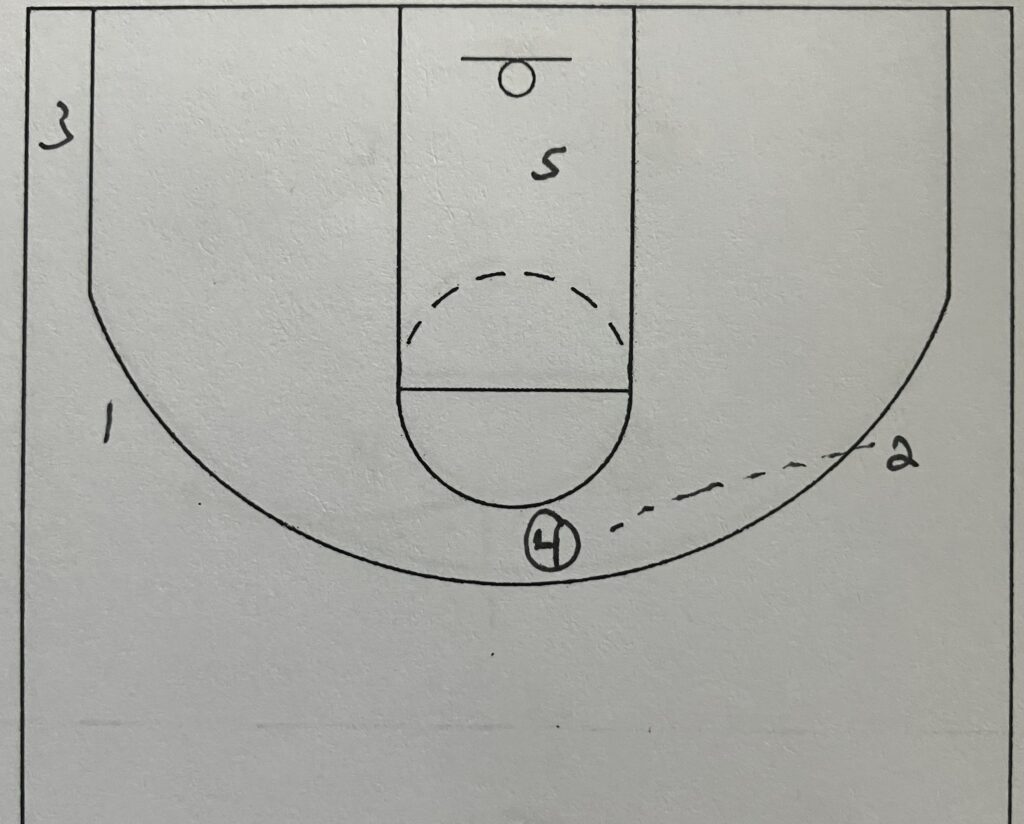
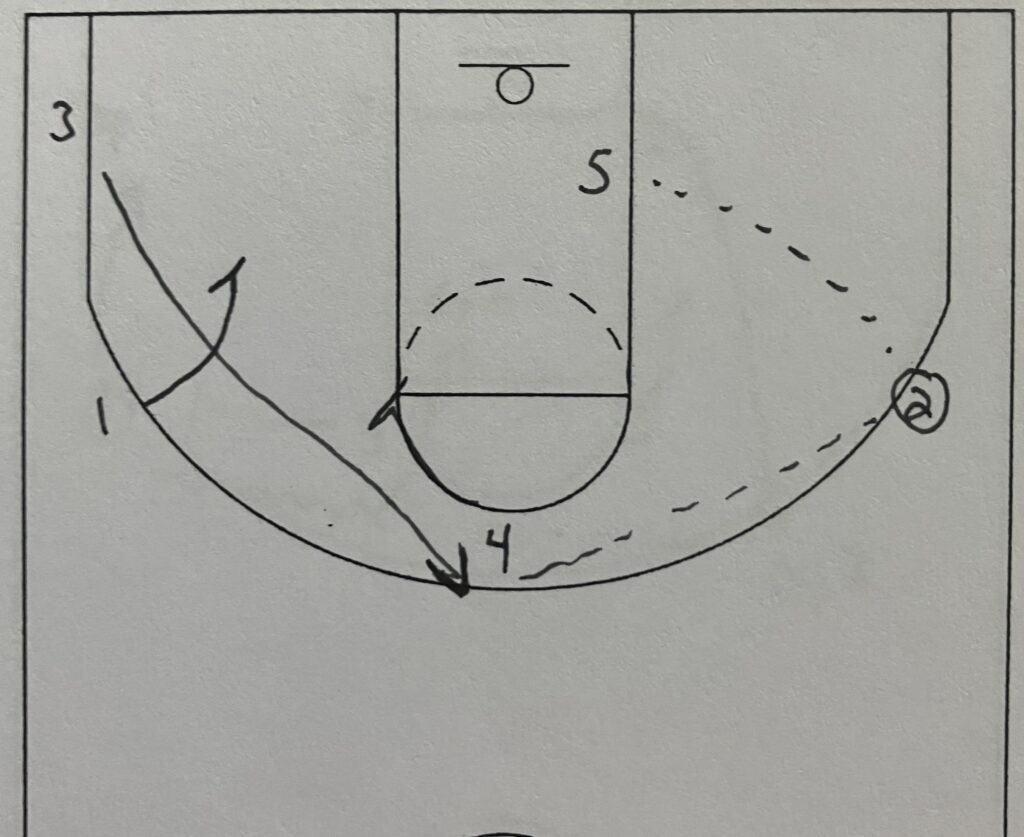
If the high low entry is not there, then the play moves into the 2nd phase. The ball is passed to the guard(2). The ball needs to be passed to the single side. In this case its the guard(2). Now the guard(2) has two options. They can pass the ball into the center(5). This gives the center(5) a 2nd chance to seal their defender and get the ball. If the post is not there, then the point(1) and forward(4) are setting a double stagger screen away for the wing(3) to use.
In most defenses, it is going to be the wing(3) defender coming across to show help in the post. If their defender is helping the center(5) defender with the post, then the play is attacking them with the double screen to free up the wing(3).


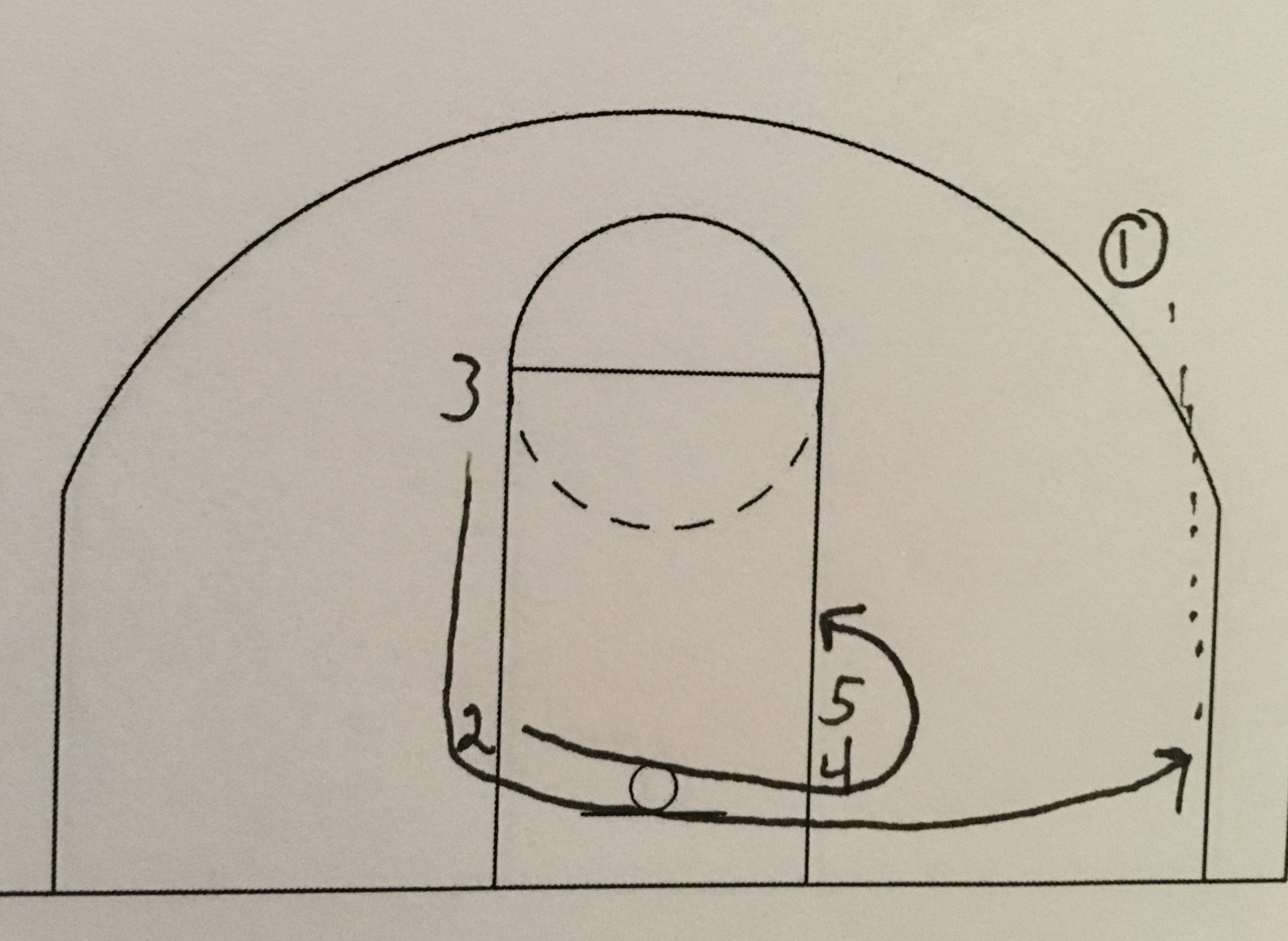

1 thought on “Horns Sets-Post Entry”